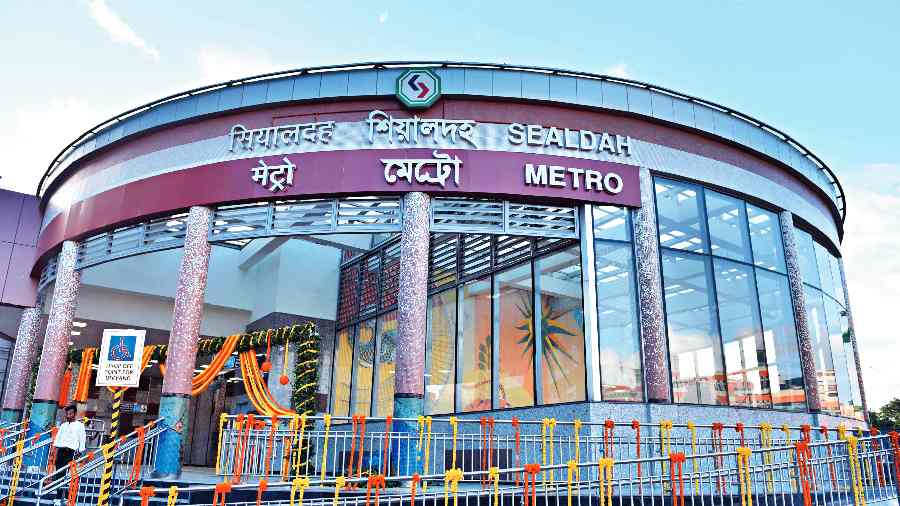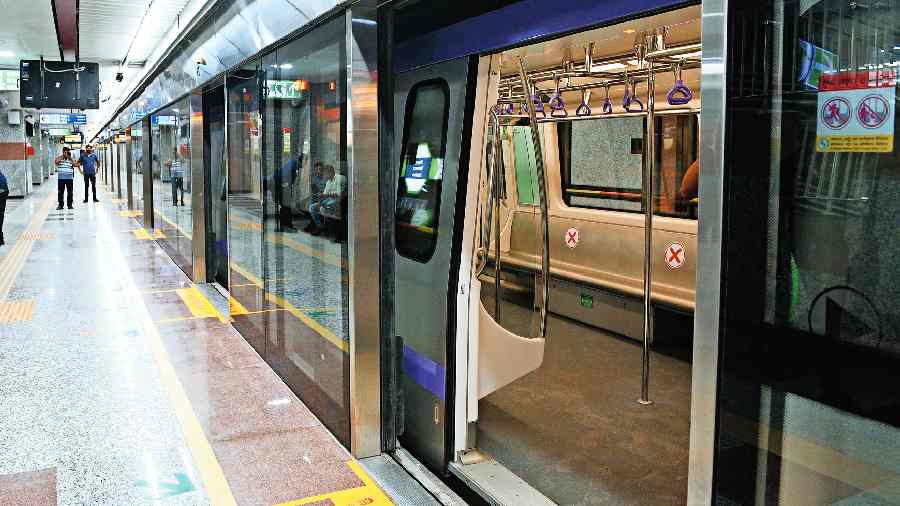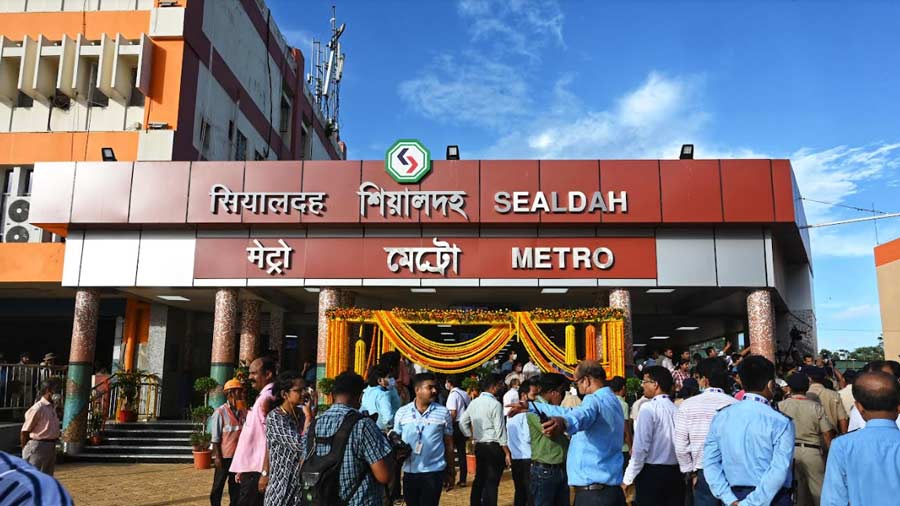At 5.54pm on Monday, a train decked out in balloons and flowers moved out of the Sealdah station of East-West Metro and went till Sector V.
The inauguration of the Sealdah Metro station was ceremonial and the train had only railway officials. Commercial services will start on Thursday.
The inauguration was described as a “milestone” moment in the East-West corridor, which spans 16.5km and will connect Howrah Maidan with Sector V once fully operational. A part of the corridor passes under the Hooghly.

The platforms of the Metro stations.
The stretch between Sector V and Salt Lake Stadium is elevated.
From Thursday, trains will run between Sector V and Sealdah. The distance is around 9.5km. The stretch between Howrah Maidan and Sealdah is still not ready.
On Monday, Smriti Irani, Union minister for women and child development and minority affairs, flagged off the train virtually from the Howrah Maidan Metro station. Before that, she visited the Sealdah Metro station.
“My maternal grandfather’s house is in Salt Lake. It is a matter of great pride for me to be able to inaugurate a train which will go to my grandfather’s house,” she said before the inauguration.
The Telegraph gives a lowdown on the Sealdah station.
Importance
Before Monday, trains ran between Phoolbagan and Sector V, ferrying a few thousand people every day. In comparison, the daily passenger volume in the north-south Metro corridor is around 5 lakh.
The first phase of East-West Metro started in February 2020, connecting Sector V with the Salt Lake stadium. In October 2020, the operational stretch was extended till Phoolbagan.
The distance between Phoolbagan and Sealdah is around 2.3km.
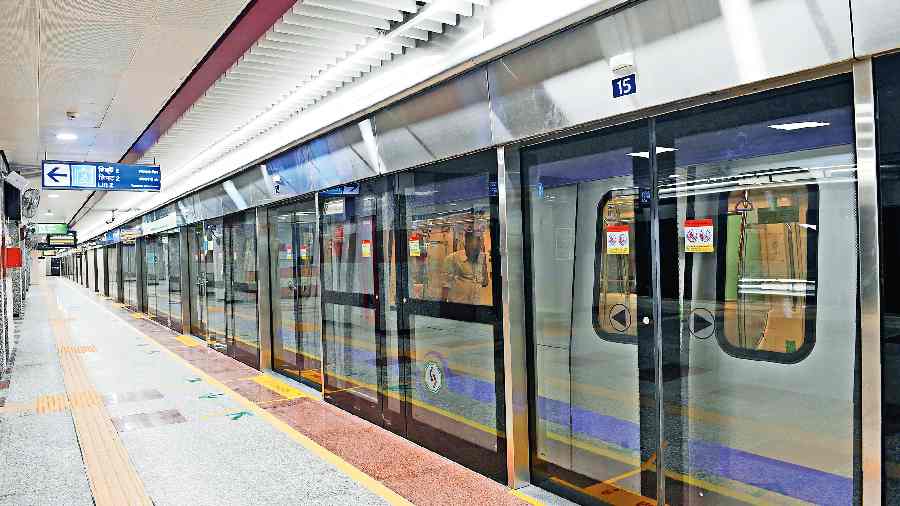
The train that made the ceremonial run seen through platform screen doors at the Sealdah Metro station
The inauguration of the Sealdah station will make the East-West Metro easily accessible for tens of thousands of passengers coming to the city on suburban trains.
One of the busiest stations in Asia, Sealdah handles around 12 lakh passengers every day, many of whom are from North and South 24-Parganas districts.
Railway officials said many of these passengers get down at Bidhannagar Road station and take public transport to Sector V. “For them, the ride to Sector V from Sealdah would be smoother and faster,” said a railway official.
In the Sealdah North/Main section, around 370 trains ply every day. In the South section, the number is around 270.
Even if a fraction of the passengers start availing themselves of East-West Metro, the passenger footfall is expected to surge substantially.
“We expect a footfall of around 30,000 in the East-West corridor with the opening of the Sealdah station,” said a Metro official.
The station
The sprawling station is the second largest in the East-West corridor, after the Howrah station which is being built.
There are four gates — A, B, C and D. Gate A leads to the Sealdah court. Gate B leads to BR Singh Hospital, NRS Medical College and Hospital and the taxi stand. Gate C leads to the south-suburban section of the Sealdah railway station.
A subway at Gate D leads to the Sealdah Main section, where passengers from northern suburbs and districts like Nadia and Murshidabad get down from local trains. The subway is not ready yet.
For now, a passenger getting off a train from Barrackpore or Barasat or Bongaon will have two options to catch a Metro. They can get down at the Main section, walk till the South section and enter the Metro station through Gate C.
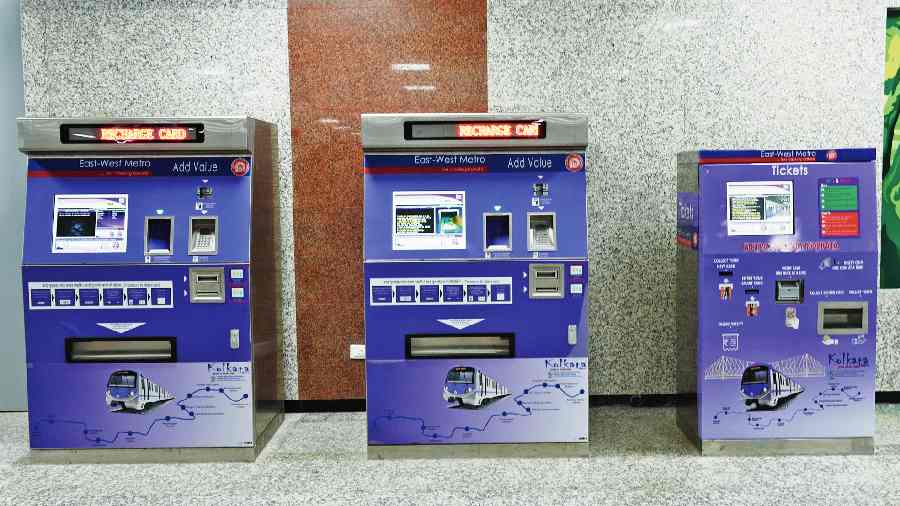
A card recharge and ticket vending machine at the station
They can also come outside the station and enter through Gate A, near the Sealdah court.
“If a person gets off a train in the South section, he will have to walk around 160m to reach the platform for Metro trains via the concourse,” said a Metro official. “Once the subway at Gate D is ready, passengers to and from the Main section will also have to walk for a similar distance before they can board a Metro train,” he said.
The Sealdah Metro station has 29 ticket booking counters, 23 smart gates, five lifts and 16 escalators. There are five ticket vending machines and five card recharge machines.
The station also has platform screen doors, which will help prevent suicides and cool air from the air-conditioned platforms to escape into the tracks.
Trains
The BEML train that made the inaugural run from Sealdah has six coaches, two less than the ones on the north-south route. The rakes, made of stainless steel, can carry 2,068 people in six coaches, compared with 3,200 an eight-coach AC rake on the north-south route can ferry.
“A train will take around 21 minutes to reach Salt Lake from Sealdah,” said a Metro official. The same journey on the road now often takes around an hour during rush hours.

The interiors of the rake
Timings
“The first and last trains will leave Sealdah at 6.55am and 9.35pm respectively. Till Wednesday, there were 48 services between Phoolbagan and Sector V. From Thursday, there will be 100 services,” said Ekalabya Chakraborty, spokesperson for Metro Railway.
The frequency will be 15 minutes during rush hours and 20 minutes during the non-rush hours, said another official.
Fare
There are six stations between Sealdah and Sector V — Phoolbagan, Salt Lake stadium, Bengal Chemical, City Centre, Central Park and Karunamoyee. From Sealdah, the fare till Bengal Chemical is Rs 10 and to any destination beyond, Rs 20.
“There will be two counters for suburban railway tickets inside the Metro complex,” said an official of the Sealdah division.
There will be separate fare systems for Metro and suburban trains. The tickets or monthly cards will not be integrated, said railway officials.
